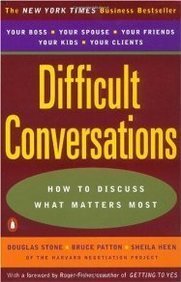- The Good: Multiple versions of example conversations
- The Bad: Surface-level advice; promotes corporate priorities
- The Literary: n/a
We all have difficult conversations, or we avoid them. From firing an employee, to decisions on how to raise children, to even simply saying “I’m sorry”, three authors from the Harvard Negotiation Project advocate for a step-by-step approach to having tough conversations with less stress, no matter the topic.
I picked up two self-help books at the library recently, though neither was exactly what I wanted; they are in the right direction. Difficult Conversations is written by committee, by a rather pretentious sounding group of experts, but it’s surprisingly accessible, if not necessarily practical.
Breaking down and understanding the three dimensions of a difficult conversation will help distinguish between what is true versus what is important. The practical substance (i.e. what happened), the emotional subtext, and the identity subtext. There are a true set of facts, yes, but it’s the differences in each of our stories that cause conflict.
But the emotions surrounding the facts are often where true breakthroughs happen. Don’t assume the other person is trying to hurt you and remove defensiveness as much as possible. Ask about the circumstances around the topic, i.e. the emotional and identity subtext. These conversations can shake our own self-images and identity.
The lessons are simple: Listen, really listen. Ask questions. Try to understand their story and what’s at stake for them. Acknowledge their story and frustrations. Don’t assume intentions. Don’t talk about blame, instead, focus on your contribution to the problem. Let go of trying to control or anticipate their reaction.
Unfortunately, each recommendation feels like well-articulated common sense, delivered with a patronizing tone. There’s little practical advice for the heat of the moment, when we all tend to accuse and say things we don’t mean or put up defensive walls. Assuming the best of everyone is great in theory, but there’s no advice for abusers and those acting in bad faith.
From a corporate standpoint, this is written from the viewpoint of the managers—not the individual contributors—for whom it’s often the people in power who need to listen more instead of sharing their side of the story. One of the examples is an employee who wants to decline working over the weekend, and even after he articulates his boundaries, must understand that either his boss will be mad or that he will be fired. Which may be true, but the perspective seems to support the corporate agenda over the need for work/life balance.
Even worse, another story is about a sexual harassment case (though it’s not called as such), and the victim must acknowledge what she did to encourage the perpetrator, which includes meeting with him one on one and listening to his ideas, then meeting with him privately again to set boundaries.
This falls squarely into the category should have been an article instead of a book.
